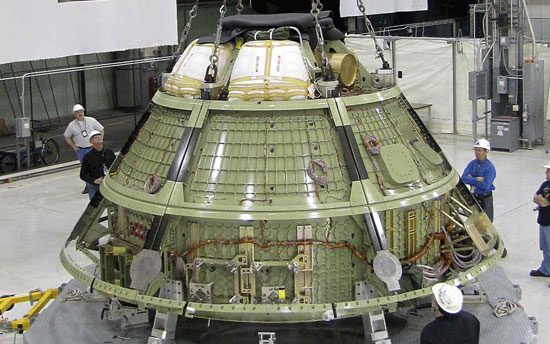Conquer asteroids to save humanity
NASA is making efforts to send astronauts to asteroids in 15 years. This is an almost impossible task.

Lockheed Martin is taking over the construction of the Orion capsule ship - Photo: NASA
Those who have witnessed the historic moment of the US aerospace industry believe that it is possible to return to the moon rather than landing a spacecraft onto an asteroid of an uncertain period. However, many NASA minds are really excited by this goal, arguing that the existence of human civilization depends on it. Asteroid is a giant rock that revolves around the sun, like the earth. And one day it might crash into the green planet, as predicted by experts.
Difficulties pile up
Sending people to asteroids is not as easy as the actor Will Willis's Armageddon film starred in 1998. You can't land on an asteroid because you will be thrown out into space soon after, due to It has no gravity. Although astronauts straight up the meteorite surface, astronauts also find it difficult to set foot on the ground if they don't want to be swept out.
NASA is brainstorming enough ways to keep astronauts floating on the asteroid surface, from jet backpacks, chains, bungee jumpers, nets to spider webs. The spacecraft deployed in this mission must blend the type of spacecraft in the Star Trek series and the deep-sea detection device with crab-like robotic arms. The most important goal is how to plug the spacecraft onto the asteroid surface; The ship must be small to be easy to move, as well as enough space for astronauts to stay from 1 to 2 weeks or more.
Recent calculations show that it takes about half a year to reach the nearest asteroids. However, the jet system for such a long journey in the universe has not been completed. In order to be able to provide enough energy for the spacecraft's operation, a large plate of a new football field is required to collect solar energy. Cruise ships must also satisfy the conditions of protecting astronauts from dangerous rays from the sun and the universe. All of this means NASA will be forced to design a tightly linked system like a miniature international space station. And yet, choosing the right rally point is also a difficult challenge to swallow this program. And everything must be done somewhere in 2025 on the orders of US President Barack Obama.
Mission to prevent disaster
Despite these difficulties, it is not difficult to understand why NASA still managed to achieve that new goal. The agency has sent a ship to study asteroids for many years, and even landed on an asteroid nearly 10 years ago. Last week, an exploration spacecraft began revolving around a giant asteroid called Vesta , farther away than Mars. Besides, while the mission to send people to Mars is difficult to implement but expensive, landing on asteroids is much more significant. In addition to studying the formation of the solar system, setting foot on an asteroid can prevent a terrible risk, when every 100 million years an asteroid nearly 100 km in diameter hits the earth . If the research is thorough, experts hope to change its direction, avoid the disaster of destruction for the planet.
NASA promises to offer the necessary rocket design later this summer, and the US Congress has ordered them to be built in 2016. All hopes are pouring into the new space probe Orion, spent more than $ 5 billion in investment, to bring the crew into space. And then NASA just got half way.
- NASA returned to the moon?
- NASA hangs on the asteroid
- Change candidates for hunting asteroids
- 10 interesting things about asteroids in the solar system
- 4 asteroids are threatening the Earth
- Why does invading a planet need 40,000 people?
- NASA plans to conquer metal planet in the near future
- Identify asteroids to lead near Earth
- Four asteroids are flying past the Earth
- Asteroids are about to fly through the earth
- Researchers lost 900 marks of asteroids near Earth
- Map of asteroids in the solar system for nearly 20 years
 Van Allen's belt and evidence that the Apollo 11 mission to the Moon was myth
Van Allen's belt and evidence that the Apollo 11 mission to the Moon was myth The levels of civilization in the universe (Kardashev scale)
The levels of civilization in the universe (Kardashev scale) Today Mars, the sun and the Earth are aligned
Today Mars, the sun and the Earth are aligned The Amazon owner announced a secret plan to build a space base for thousands of people
The Amazon owner announced a secret plan to build a space base for thousands of people NASA begins opening extraterrestrial capsule, risk of strange bacteria entering?
NASA begins opening extraterrestrial capsule, risk of strange bacteria entering?  NASA taps gold mine worth 70,000 times the global economy
NASA taps gold mine worth 70,000 times the global economy  The mystery of the Tunguska explosion may have been solved, the real cause was a drifting meteorite phenomenon
The mystery of the Tunguska explosion may have been solved, the real cause was a drifting meteorite phenomenon  Earth Says Goodbye to 'Mini Moon'
Earth Says Goodbye to 'Mini Moon'  Super telescope finds unbelievable thing flying between Mars and Jupiter
Super telescope finds unbelievable thing flying between Mars and Jupiter  ESA launches Hera spacecraft to study how to protect Earth
ESA launches Hera spacecraft to study how to protect Earth 